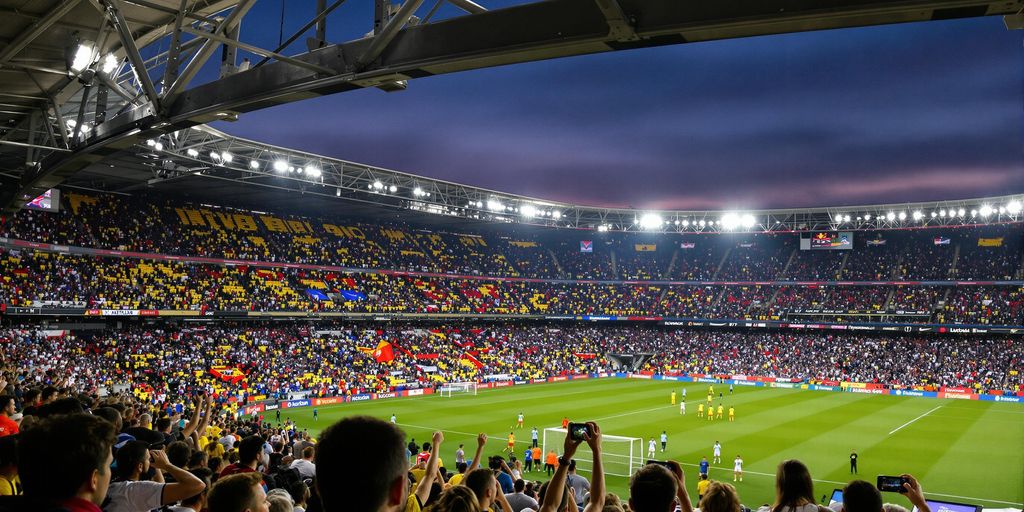The Origins of A-League Football

Founding Principles of the A-League
The A-League was born out of a need for a fresh start for professional football in Australia. The old National Soccer League (NSL) had its problems, and Football Australia (then Soccer Australia) wanted something new. The A-League was designed to be more professional, more marketable, and more sustainable than its predecessor. Key principles included a salary cap to ensure competitive balance, a focus on marquee players to attract fans, and a commitment to youth development. It was all about building a league that could stand the test of time and really capture the imagination of the Aussie public.
Initial Teams and Structure
When the A-League kicked off, it featured eight teams, mostly based in major cities along the east coast. We had Adelaide United, Brisbane Roar (then Queensland Roar), Central Coast Mariners, Melbourne Victory, Newcastle Jets, Perth Glory, Sydney FC, and the New Zealand Knights (based in Auckland). The structure was pretty straightforward: a regular season followed by a finals series to determine the champion. The idea was to create a compelling narrative throughout the season, culminating in a high-stakes finale. It wasn’t perfect, but it was a start.
The Role of Football Australia
Football Australia (FA) played a crucial role in establishing and shaping the A-League. They were responsible for setting the rules, managing the league, and promoting the sport. FA also worked to attract investment and secure broadcast deals. However, the relationship between FA and the A-League hasn’t always been smooth sailing. There have been disagreements over strategy, funding, and control. It’s a complex dynamic, but FA’s involvement has been essential to the A-League’s existence.
The early days of the A-League were a bit of a mixed bag. There was excitement and optimism, but also plenty of challenges. Getting fans on board, building a strong financial base, and competing with other popular sports were all tough tasks. But the A-League has shown resilience and a willingness to adapt, which has helped it survive and grow over the years.
Key Milestones in A-League History

The Inaugural Season
Okay, so where did it all begin? The first A-League season kicked off in 2005, and it was a pretty big deal. Finally, Australia had a national football league with a bit of oomph behind it. It wasn’t perfect, but it was a start. I remember watching those early games – the atmosphere was electric, even if the quality of play was still finding its feet. It was a breath of fresh air after the old NSL.
Expansion of Teams
Over the years, the A-League has seen teams come and go, and the expansion of teams has been a big part of the story. New teams brought new rivalries, new fans, and new challenges. Think about it, more teams means more games, more opportunities for local talent, and a bigger footprint for the sport across the country. It’s not always been smooth sailing, but the growth has been pretty impressive to watch.
Introduction of the Finals Series
The finals series is where things get really interesting. It’s the culmination of the regular season, and it’s where legends are made (and sometimes, hearts are broken). The introduction of the finals series added a whole new level of excitement and drama to the A-League. It gives every team a shot at glory, no matter where they finished on the ladder. Plus, who doesn’t love a good grand final?
The Impact of Globalisation on A-League
International Investments in Clubs
Globalisation has really changed the A-League, especially with more international investment. You see ownership groups from overseas buying into clubs, which brings in new money and ideas. It’s not always smooth sailing, but it definitely shakes things up. Some clubs have really benefited from this, getting better facilities and being able to attract better players. It’s a bit of a mixed bag, but overall, it’s made the league more interesting.
Player Transfers and Market Growth
The player transfer market has gone nuts. A-League players are now worth more on the global market, which means there’s more interest in them moving between clubs, both here and overseas. This has led to longer contract terms and more complex negotiations. It’s a sign that the A-League is becoming more competitive and that our players are getting recognised internationally. It also means clubs need to be smarter about how they buy and sell players.
Global Partnerships and Collaborations
The A-League has been forming partnerships with leagues and organisations around the world. This helps with things like player development, coaching, and even just getting more exposure for the league. These partnerships can lead to better training programmes and opportunities for young players to go overseas and gain experience. It’s all about trying to raise the standard of football in Australia.
The globalisation of football has presented both opportunities and challenges for the A-League. While it has brought in new investment and talent, it has also increased competition and the need for clubs to be financially sustainable. The league needs to find a balance between embracing global trends and maintaining its own unique identity.
A-League’s Development Strategies
Youth Development Programmes
Okay, so the A-League’s really trying to pump up its youth development, right? It’s all about getting young players ready for the big leagues. These programmes are designed to give them the skills, training, and mentoring they need. Think of it as a footy finishing school. They’re also trying to make sure coaches are properly trained, because good coaches make good players, simple as that. The A-League Draught scouting promising players is a big part of this, getting fresh blood into the system.
It’s not just about the elite players, though. It’s about getting more kids involved in the sport at the grassroots level. More kids playing means more talent coming through the ranks.
Here’s a few things they’re focusing on:
- Better coaching at junior levels
- More access to facilities
- Stronger links between clubs and schools
Talent Identification Initiatives
Finding the next big thing is a massive focus. Football Australia is working hard to make sure they don’t miss any potential stars. They’re using data more and more to spot talent, which is pretty cool. It’s not just about who looks good on the field; it’s about digging into the numbers to see who’s got the potential to be great. They’re also trying to make sure there are plenty of opportunities for young players to be seen, no matter where they are in the country. The talent pathways junior leagues and academies are key to this.
- National Premier League Clubs
- Australian Professional League Clubs
- Schools
Community Engagement Efforts
It’s not just about what happens on the pitch; it’s about getting the community involved. The A-League is trying to build a real connection with fans, making them feel like they’re part of something special. This means getting out into the community, running events, and making sure everyone feels welcome. The fan engagement programmes interactive game-day atmosphere are pivotal in bridging the gap between the teams and their supporters.
Here’s how they’re doing it:
- Running school programmes
- Hosting community events
- Working with local charities
The Evolution of A-League Governance
Changes in Leadership Structures
It’s interesting to see how the A-League’s leadership has changed over the years. Initially, Football Australia had a pretty tight grip, but as the league has matured, there’s been a push for more independence and a greater say for the clubs themselves. This has led to the formation of the APL (Australian Professional Leagues), which now runs the A-League. It’s all about finding the right balance between national oversight and club autonomy. The shift reflects a broader trend in sports, where football clubs are becoming more like businesses.
Regulatory Framework Adjustments
The rules and regulations governing the A-League are constantly being tweaked to keep up with the times. One big change has been around player transfers. For a while, there were restrictions on clubs buying and selling players between each other, but that’s starting to loosen up. This is because the globalisation of football has made it more common for players to move between A-League clubs, and the old rules just weren’t working anymore.
Here’s a quick look at some key regulatory areas:
- Salary Cap: Designed to ensure competitive balance.
- Player Eligibility: Rules around foreign players and youth development.
- Club Licencing: Criteria for clubs to participate in the league.
It’s a constant balancing act. The league wants to encourage investment and growth, but it also needs to make sure that all clubs have a fair go and that the competition remains exciting for the fans.
Collaborations with Player Associations
The PFA (Professional Footballers Australia) plays a big role in shaping the A-League. They represent the players’ interests and work with the league on things like wages, working conditions, and player development. It’s not always smooth sailing, but having a strong player association is important for ensuring that the players have a voice and that the league is run fairly. The Professional Football Committees within the APL and PFA help review the A-Leagues by regularly assessing key strategic matters. These committees include representation from the APL, clubs, and players.
Technological Advancements in A-League
Broadcast Innovations
The way we watch the A-League has changed heaps over the years, and it’s only getting more advanced. Remember the days of grainy TV broadcasts? Now we’ve got 4K, high frame rates, and all sorts of fancy camera angles. The A-League has really embraced streaming services, which means you can catch every game on your phone, tablet, or smart TV.
- Improved picture quality (4K/HDR)
- More camera angles and perspectives
- Interactive viewing experiences
It’s not just about watching the game anymore; it’s about being immersed in it. The A-League is trying to give fans a more engaging experience, whether it’s through better replays or real-time stats on your screen.
Data Analytics in Player Performance
Data is king in modern football, and the A-League is no exception. Clubs are using data analytics to scout players, track performance, and even make tactical decisions during games. It’s all about finding that extra edge. For example, clubs might use GPS data to track how far a player runs during a match, or video analysis to identify weaknesses in the opposition’s defence. This helps with player development.
- Player tracking (GPS, wearables)
- Performance analysis (video, stats)
- Injury prevention (predictive analytics)
Fan Engagement Technologies
Getting fans involved is a big deal, and technology is playing a huge role. From interactive apps to social media campaigns, the A-League is trying to connect with supporters in new and exciting ways. Think about things like fantasy football, prediction games, and even virtual reality experiences. It’s all about making fans feel like they’re part of the action. The A-League is also looking at ways to use technology to improve the matchday experience, like mobile ticketing and contactless payments.
| Technology | Example | Benefit |
|---|---|---|
| Mobile Apps | Team apps with news and scores | Increased fan engagement |
| Social Media | Interactive polls and Q&As | Direct interaction with fans |
| Virtual Reality (VR) | Simulated matchday experiences | Immersive fan experience |
Cultural Significance of A-League Football
Promotion of Diversity and Inclusion
The A-League has really stepped up its game when it comes to diversity. It’s not just about having players from different backgrounds, but also creating a welcoming environment for everyone – fans, staff, and the community. The league actively promotes inclusion through various programmes and initiatives, making sure everyone feels like they belong. It’s about more than just football; it’s about building a community that reflects Australia’s multicultural identity. The A-League’s commitment to diversity and inclusion is evident in its outreach programmes and community events.
Celebration of Indigenous Heritage
The A-League is making a real effort to acknowledge and celebrate the heritage of Indigenous Australians. This isn’t just a token gesture; it’s about embedding Indigenous culture into the fabric of the league. You see it in things like:
- Special jerseys designed by Indigenous artists.
- Welcome to Country ceremonies before matches.
- Partnerships with Indigenous communities.
It’s about recognising the deep history of this land and ensuring that Indigenous voices are heard and respected within the football community. It’s a journey, but the A-League is taking steps in the right direction.
Community Building through Football
Football, at its heart, is a community sport. The A-League plays a big role in bringing people together, creating a sense of belonging and shared identity. Local derbies are more than just games; they’re community events that get everyone involved. The league also runs a bunch of community programmes, like school visits and coaching clinics, that help to connect with fans on a personal level. It’s about using football as a tool to build stronger, more connected communities. The A-League’s community engagement efforts are vital for growing the sport’s popularity.
Challenges Facing A-League Football
Financial Sustainability Issues
Let’s be real, keeping the A-League afloat financially is a constant worry. It’s not like the EPL where money seems to grow on trees. We’re talking about a league that’s still trying to find its feet in a market dominated by other sports. The struggle to attract big sponsorships and TV deals is real, and it directly impacts the clubs’ ability to invest in players and infrastructure. It’s a bit of a chicken-and-egg situation: you need quality to attract fans, but you need money to get quality. The new spending cap is designed to help, but it’s a band-aid solution at best.
- Limited broadcast revenue compared to other leagues.
- Reliance on owner investment, which can be unstable.
- Difficulty attracting major sponsors.
The A-League needs to find a way to become self-sufficient, rather than relying on handouts or the whims of wealthy owners. A sustainable financial model is the only way to ensure the league’s long-term survival.
Competition from Other Sports
Australia is a sports-mad nation, but football isn’t always top of the list. We’re up against Aussie Rules, rugby league, rugby union, cricket… the list goes on. These sports have a long history and a strong cultural connection with Aussies. Trying to compete for eyeballs and dollars is tough. The AFL and NRL have massive fan bases and well-established pathways. The A-League needs to carve out its own niche and offer something different to attract and retain fans.
- Established popularity of AFL and NRL.
- Strong grassroots participation in other sports.
- Limited media coverage compared to rival codes.
Maintaining Fan Engagement
Getting people to games and keeping them interested is a constant battle. The A-League has had its ups and downs in terms of attendances and TV ratings. The quality of the product on the pitch is important, but so is the overall fan experience. We need to make going to a game something special, something that people want to do week in, week out. That means better stadiums, better atmosphere, and better engagement with fans online and offline. The fixture creation is important to get right.
- Fluctuating match attendance figures.
- Competition from at-home entertainment options.
- Need for improved stadium infrastructure and atmosphere.
Future Directions for A-League
Vision for the Next Decade
Looking ahead, the A-League needs a clear vision to thrive. This involves solidifying its position in the Australian sporting landscape and expanding its reach both domestically and internationally. A key focus will be on enhancing the league’s brand and attracting a new generation of fans. We need to see more investment in marketing and promotion, showcasing the talent and excitement that the A-League has to offer. The next decade should see the A-League become a more commercially viable and culturally significant part of Australian life. It’s about building a sustainable future where the league can compete with other popular sports and provide a pathway for young Australian talent to shine. The A-League’s economic model needs to be robust.
Potential Expansion Plans
Expansion is always a hot topic. Should the A-League add more teams? If so, where? There are a few ways to think about this. First, we need to consider the existing markets. Are there untapped areas with a strong football following? Secondly, we need to look at the financial viability of new teams. Can they attract investment and build a sustainable fanbase? Finally, expansion needs to be strategic. It’s not just about adding more teams; it’s about adding the right teams in the right locations. Here are some potential expansion locations:
- Canberra
- Tasmania
- A second team in Brisbane
Expansion needs to be carefully managed to avoid diluting the talent pool and creating financial instability. It’s a balancing act between growth and sustainability.
Sustainability Initiatives
Sustainability isn’t just about the environment; it’s about the long-term health of the A-League. This means financial sustainability for clubs, sustainable player development pathways, and sustainable community engagement. Clubs need to find ways to generate revenue beyond ticket sales and sponsorships. This could involve exploring new commercial opportunities, such as merchandise sales, digital content, and community programmes. Player development needs to focus on creating a pipeline of young Australian talent who can compete at the highest level. And community engagement needs to be genuine and meaningful, building strong relationships with local communities and fostering a sense of belonging. The Liberty A-League Women’s is a great example of growth.
The Role of Women in A-League Football
Growth of Women’s Football
Okay, so women’s footy in the A-League, right? It’s not just ‘there’ anymore; it’s actually growing, and at a decent pace. We’re seeing more games, more coverage, and, crucially, more investment. The quality of play has improved massively, and that’s drawing bigger crowds and more interest overall. It’s not just about having a women’s league; it’s about making it a good league.
Integration of Women’s Teams
Integrating the women’s teams hasn’t always been smooth sailing, but things are getting better. It’s about making sure they get the same resources, the same opportunities, and the same respect as the men’s teams. This means better training facilities, fair pay, and proper marketing. It’s also about changing the culture within the clubs to be more inclusive. The A-Leagues Professional Football Committee reviews the A-Leagues by regularly assessing key strategic matters including commercial, broadcast, and high-performance areas and the A-Leagues’ economic model. The Committees include representation from the APL, clubs and players.
Impact of AFLW on A-League
The AFLW has definitely shaken things up. It’s another option for female athletes, and it’s raised the bar for women’s sports in general. The A-League needs to stay competitive by offering something unique and compelling. This could be better pathways for young players, more international opportunities, or a stronger focus on the football culture. It’s not just about competing; it’s about offering a different, but equally attractive, option. Australia will host a series of exciting international soccer matches in 2024.
The rise of AFLW has forced A-League to re-evaluate its approach to women’s football. It’s no longer enough to just have a league; it needs to be a league that players want to be a part of.
Here’s a few things that could help:
- Increased investment in youth development programmes.
- Better marketing and promotion of women’s games.
- Creating stronger links with international clubs.
A-League’s Contribution to Australian Football
The A-League’s impact on the broader Australian football landscape is undeniable. It’s not just about what happens on the pitch; it’s about building a sustainable football culture from the ground up. The league has played a vital role in developing local talent, raising Australia’s profile on the global stage, and fostering a deeper love for the game across the nation. It’s been a journey with its ups and downs, but the overall trajectory is positive, with the A-League becoming an increasingly important part of the Australian sporting identity.
Development of Local Talent
The A-League has become a crucial stepping stone for young Australian footballers. It provides a professional environment where they can hone their skills and gain valuable experience. Before the A-League, many aspiring players had to look overseas for opportunities, but now, they have a viable pathway right here at home. The league’s focus on youth development programmes is starting to pay dividends, with more and more Australian players making their mark both domestically and internationally. It’s great to see the SANFL history being mirrored in the A-League, with local talent getting a chance to shine.
Enhancing Australia’s Global Football Standing
The A-League’s presence has undoubtedly boosted Australia’s reputation in the global football community. By attracting international players and coaches, the league has raised the overall standard of play and exposed local players to different styles and approaches. This increased exposure has helped Australian clubs compete more effectively in Asian Champions League and other international competitions. Plus, a stronger domestic league makes the national team, the Socceroos, more competitive on the world stage. It’s all connected, and the A-League is a key part of that connection.
Building a Football Culture in Australia
Perhaps the most significant contribution of the A-League is its role in building a genuine football culture in Australia. For years, football struggled to compete with more established sports like Aussie Rules and rugby. But the A-League has helped to change that, creating a dedicated fan base and fostering a sense of community around the game. This is achieved through:
- Active community engagement programmes.
- Family-friendly match day experiences.
- Promotion of diversity and inclusion within the sport.
The A-League is more than just a football competition; it’s a cultural movement. It’s about creating a space where people from all backgrounds can come together to celebrate the beautiful game. It’s about building a legacy that will last for generations to come. Football is finally getting the recognition it deserves in Australia.
It’s not always easy, and there are still challenges to overcome, but the A-League is making a real difference in shaping the future of football in Australia.
Looking Ahead: The Future of A-League Football
As we wrap up our look at the A-League’s journey, it’s clear that the future holds plenty of promise. The league has come a long way since its early days, and with ongoing changes, it seems set to keep evolving. Fans are more engaged than ever, and clubs are finding new ways to connect with their communities. The push for better player development and inclusivity is also a big step in the right direction. Sure, there are challenges ahead, but the excitement around the game is palpable. As we head into 2025, one thing’s for sure: A-League football is here to stay, and it’s only going to get better.




